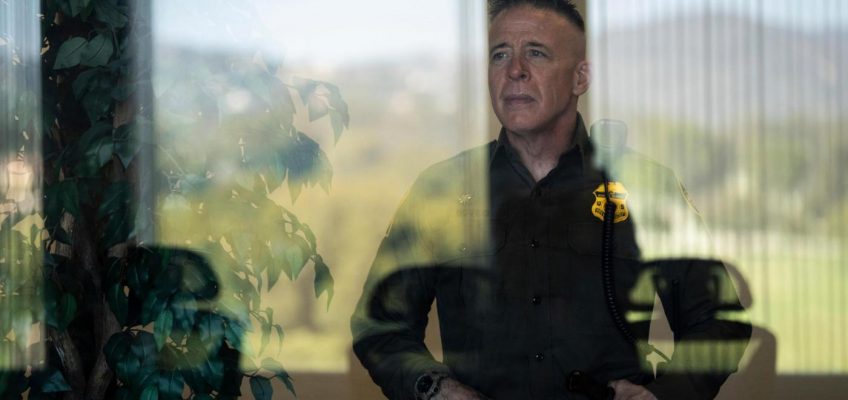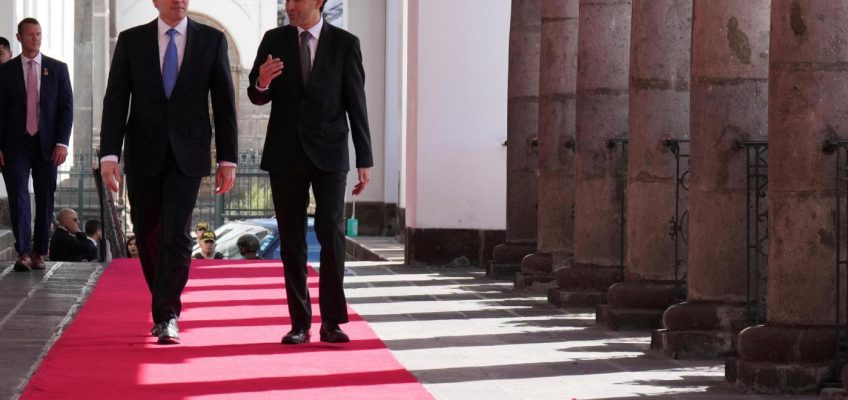By ELLIOT SPAGAT
LOS ANGELES (AP) — Gregory Bovino’s distinguished Border Patrol career was in a downward spiral. In August 2023, he was relieved of command of the agency’s El Centro, California, sector, where he rose to be one of 20 regional chiefs across the country.
The president blamed AI and embraced doing so. Is it becoming the new ‘fake news’?
‘It’s happening everywhere’: 1 in 3 ICE detainees held in overcrowded facilities, data show
Trump’s Fed nominee says he’d keep his White House job even if confirmed by the Senate
Americans would save $100B if credit card rates were capped as Trump proposed, researchers say
If Trump’s biggest tariffs get thrown out, companies could get a refund — but not consumers
Bovino blamed a batch of perceived transgressions, details of which have not been previously reported: an online profile picture of him posing with an M4 assault rifle; social media posts that were considered inappropriate; and sworn congressional testimony that he and other sector chiefs gave on the state of the border during a record surge of migrants.
Thirty minutes after his second congressional hearing, Bovino said, he was removed from his position and asked, “Are you going to retire now?”
He did not retire, the profile photo with the assault rifle is back online and, at 55, he is leading immigration enforcement in Los Angeles, which the federal government has called “ground zero for the effects of the border crisis.” Bovino’s fall and rise illustrates how fundamentally immigration policy, tactics and messaging have changed under President Donald Trump.
While Trump’s aggressive deportation plans accelerate, Bovino carefully hones his image, both his own and the one projected to the country that shows well-armed officers moving swiftly into place to make arrests.
On a recent August morning, several unmarked SUVs with tinted windows sped to the curb outside a Home Depot in the Van Nuys area of Los Angeles. A Guatemalan tamale vendor was handcuffed while men with M4 rifles and military-style gear watched over and day laborers fled. Protesters sounded sirens and whistles. One briefly blocked a Border Patrol vehicle, but agents left in a little more than four minutes.
The same team, dressed as civilians with faces masked and badges on their waists, stormed a car wash in the suburb of Montebello around 11:30 a.m. They made four arrests, including a Guatemalan worker who fled down an alley and a Mexican employee who was tackled after running into the office. It was over in seven minutes.
These were just the kind of fast-paced, blunt maneuvers that Bovino relishes. With a knack for made-for-TV moments, Bovino’s operation has riven parts of Los Angeles and given Trump allies fodder for boasts.
Gregory Bovino, chief patrol agent of the U.S. Border Patrol’s El Centro Sector, speaks during an interview with The Associated Press in Los Angeles, Monday, Aug. 25, 2025. (AP Photo/Jae C. Hong)
In a city famous for second acts, Bovino is certainly having one. The North Carolina native with ample biceps and hair spiked with gel is an avatar of the Trump era, once scorned for his tactics, now praised because of them.
With the change from President Joe Biden to Trump, Bovino has gone from nearly being forced to retire to a MAGA-world hero who sends holiday cards to colleagues that show agents with heavy weapons.
Undeterred by court orders over racial profiling, Bovino also revels in breaking norms. Agents have smashed car windows, blown open a door to a house and patrolled the fabled MacArthur Park on horseback. Bovino often appears in tactical gear, as he did outside Gov. Gavin Newsom’s news conference on congressional redistricting on Aug. 14.
He also knows the power of a good slogan, calling the pacing of his operation “turn and burn.”
“We’re not going to hit one location, we’re going to hit as many as we can,” Bovino said in an interview in a seventh-floor conference room of the federal building in West Los Angeles, where an unused office wing serves as a sparsely furnished temporary base. “All over — all over — the Los Angeles region, we’re going to turn and burn to that next target and the next and the next and the next, and we’re not going to stop. We’re not going to stop until there’s not a problem here.”
As Chicago braces for a similar crackdown, the Los Angeles effort topped 5,000 arrests last week. A campaign in Washington, D.C., has resulted in many immigration arrests but is cast as a broader strike against crime and has a more central role for the National Guard. Illinois Gov. JB Pritzker said Tuesday that Bovino called the head of the state police to say immigration officials were coming to Chicago, without elaborating.
The border is everywhere
U.S. Immigration and Customs Enforcement has led interior immigration enforcement since it was created in 2003, but the Border Patrol has been around much longer. Bovino’s sense of mission never strayed from the Border Patrol’s roots. When assigned to lead a station in Blythe, California, he pitched his boss, Paul Beeson, on raiding the airport and bus stations in Las Vegas.
The 2010 operation was supposed to last three days but got called off after the first hour yielded dozens of arrests and unleashed a furious reaction from then-Senate Majority Leader Harry Reid, a Nevada Democrat.
“He’s not afraid to push the envelope, very articulate, leads from the front,” said Beeson, who, as a sector chief, selected Bovino to lead stations in Blythe and in Imperial Beach, California.
In the first week of January, Bovino sent 60 agents hundreds of miles to Bakersfield, California, to make 78 arrests at farms and businesses. His staff acknowledged congratulatory comments on social media and posted photos of an encounter with someone whose car window was shattered after refusing to open it.
The Los Angeles raids, which began with a blitz of Home Depots, car washes and an apparel factory, are an extension of what Bovino considers the Border Patrol’s proper role.
“What happens at the border, even 100 years ago, didn’t stay at the border, and it still doesn’t. That’s why we’re here in Los Angeles,” he said.
Allegations of heavy-handed tactics, racial profiling
The Associated Press joined a Border Patrol-led team July 23 during a lull in high-profile raids for what resembled a typically inconspicuous ICE operation. ICE has historically made arrests in the streets after investigation of individual targets, including surveillance that an official once likened to watching paint dry. Officials rarely have judicial warrants to enter a home, causing them to wait outside.
A man is detained by immigration agents at a car wash on Friday, Aug. 15, 2025, in Montebello, Calif. (AP Photo/Gregory Bull, File)
“After this light we’re going to light him up. … Here we go,” a Border Patrol agent said on the radio while trailing a Chinese man in Rancho Cucamonga. Moments later she reported, “Suspect is in custody.”
The same team saw a Russian man enter his home in Irvine but backed off after three hours parked outside. They waited even longer for a Mexican man with a misdemeanor conviction for child molestation who never emerged from his house in El Monte, though they caught up with him two days later at a convenience store.
It’s not all turn and burn. It’s also not a pace that will lead Trump to fulfill his promises of mass deportation.
Angelica Salas, executive director of the Coalition for Humane Immigrant Rights, remembers thinking to herself, “What in the world is happening here?” when immigration authorities hit multiple locations in Los Angeles on June 6, as they have on many days since. Masked officers tackled people with lightning-quick force. “It was at another level,” she said.
Salas’ group sued and won a temporary order prohibiting arrests based on any mix of four factors: race and ethnicity; language; location; and occupation. The administration has appealed to the Supreme Court, arguing that any of those factors can help justify reasonable suspicion that someone is in the country illegally and that officers can make arrests based on the “totality of the circumstances.”
A court filing by those who sued Bovino and the government says “masked federal agents brandishing weapons cannot command people going about their daily lives to stop and prove their lawful presence solely because of their skin color, accent, where they happen to be, and the type of work they do.”
Where critics see heavy-handed racial profiling, Bovino sees legitimate use of force.
Smashing a car window when a driver refuses to open and is subject to arrest is “a safer tactic than letting someone drive away and then getting in a high-speed pursuit,” he said.
Blasting the door off a home in Huntington Park to search for a man accused of ramming a Border Patrol vehicle days earlier was a “very, very prudent, thoughtful application of tactics,” said Bovino, who joined that early-morning raid. “I don’t want to surround a house for hours and hours and hours and then create another riot.”
He dismissed allegations of profiling, saying he identifies targets based on intelligence, and he defended the optional use of masks for agents who fear that being identified may jeopardize their personal safety.
Protesters strike back
But protesters trying to counter Bovino’s raids have tactics of their own.
On a balmy Saturday morning, about 150 volunteers filed into an auditorium at the headquarters of the Los Angeles teachers union to hear a leader of the Community Self-Defense Coalition speak for two hours about how to fight back, capped by a 15-minute session of role-playing as monitors and ICE officers.
The speaker rattled off a list of most commonly used SUVs and telling signs that they are in the area, such as being double-parked, in red zones or clustered together. People were told to knock on the window to try to press officials for information and record license plates to determine if they have been spotted at other raids.
When a raid unfolds, instructions are to get personal information of those arrested and record the action.
When agents raided the Home Depot and car wash on Aug. 15, they were constantly watching for drivers who might be trailing them. The team met briefly in an office park but split up after workers started peering at their SUVs with tinted windows.
Bovino uses the term “time on the X” to describe how long agents stay at the scene of a raid; they must leave quickly to avoid protesters. On this morning, the plan was no more than 10 minutes.
The tamale vendor arrested outside the Home Depot had been under surveillance because she was previously removed from the country, though she had no criminal history. There were two targets at the car wash who were priorities because they had been previously deported, but they were apparently not there. Of the four arrested, one had previously been deported; none had criminal histories.
Bovino relies on Border Patrol SWAT-style teams to avoid the chaos that erupted during an hourslong standoff at a Home Depot in Paramount on June 7. The Trump administration called in the National Guard and Marines to counter the protests. A federal judge ruled Tuesday that use of the Guard was illegal.
Agents are developing new tactics to strike quickly, Bovino said, and to avoid protesters, as when they hid in a rented Penske truck to surprise laborers at a Home Depot last month. He said he plans to heavily promote an ICE tip line.
‘He’s going to push the limits’
In some important respects, Bovino has been consistent. The world around him has changed. He joined the Border Patrol in 1996 and is nearing the agency’s mandatory retirement age of 57. He eventually plans to return home to North Carolina to harvest apples.
Vice President JD Vance, center, speaks next to officials including, from left to right, HUD Regional Administrator William Spencer, United States Attorney for the Central District of California Bill Essayli, FBI Los Angeles Assistant Director Akil Davis, US Border Patrol Sector Chief Gregory Bovino and ICE Field Office Director Ernie Santacruz at the Wilshire Federal Building Friday, June 20, 2025, in Los Angeles. (AP Photo/Jae C. Hong, File)
For now, he remains Border Patrol chief in El Centro, long a relatively quiet part of the border that has become even quieter as illegal crossings have plummeted to their lowest levels in six decades. Roughly 1,000 agents there averaged less than three arrests a day in July.
His media savvy is on display each summer when Border Patrol sector chiefs hold news conferences to warn against illegal crossings. In 2021, Bovino led journalists in swimming across the All-American Canal, whose deceptively swift current and smooth concrete lining result in migrant deaths every year. In 2023, he locked reporters in a vehicle trunk, saying he wanted them to appreciate the dangers firsthand.
While administration officials like to say they are deporting the “worst of the worst,” Bovino embraces arrests of hard-working people with deep roots in the country. He said they “skip the line” ahead of people waiting to enter the country legally.
“The folks undercutting American businesses, is that right?” he said. “Absolutely not. That’s why we have immigration laws in the first place, and that’s why I’m here.”
Some colleagues think Bovino he may rise higher; he has been under consideration to lead a Los Angeles-style operation in Chicago. The Homeland Security Department, asked for comment, says, “Bovino’s success in getting the worst of the worst out of the Los Angeles region speaks for itself.”
“He sees what the right and left lanes are on this, and he’s going to get out there and he’s going push the limits,” Beeson said.




